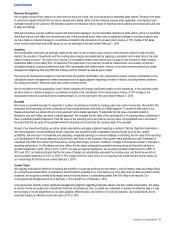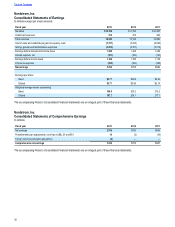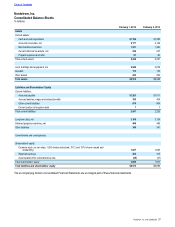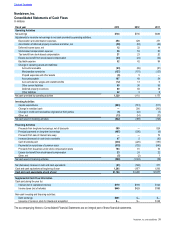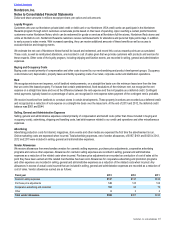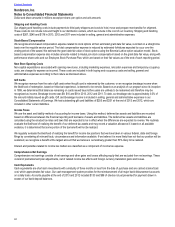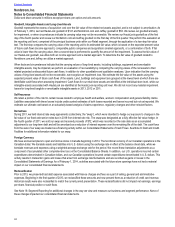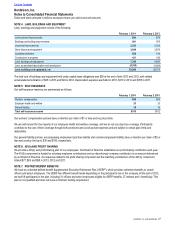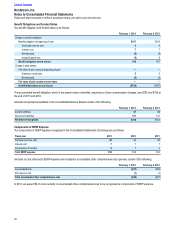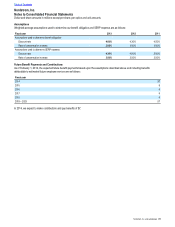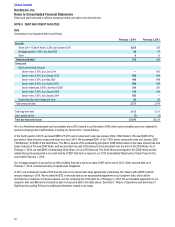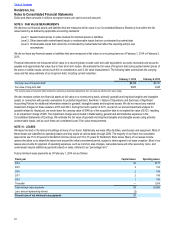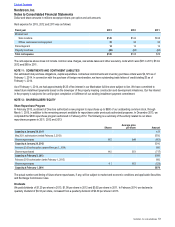Nordstrom 2013 Annual Report Download - page 43
Download and view the complete annual report
Please find page 43 of the 2013 Nordstrom annual report below. You can navigate through the pages in the report by either clicking on the pages listed below, or by using the keyword search tool below to find specific information within the annual report.
Nordstrom, Inc. and subsidiaries 43
Accounts Receivable
Accounts receivable includes credit card receivables from our Nordstrom private label and VISA credit cards, as well as credit and debit card
receivables due from third-parties. We record credit card receivables on our Consolidated Balance Sheets at the outstanding balance, net of
an allowance for credit losses. The allowance for credit losses reflects our best estimate of the losses inherent in our receivables as of the
balance sheet date, including uncollectible finance charges and fees. We estimate such credit losses based on several factors, including
historical aging and delinquency trends, write-off experience, concentration and risk metrics and general economic conditions. For purposes
of determining impairment and recording the associated allowance for credit losses, we evaluate our credit card receivables on a collective
basis as they are composed of large groups of smaller-balance homogeneous loans and, therefore, are not individually evaluated for
impairment. We record estimated uncollectible principal balances to bad debt expense while estimated uncollectible finance charges and fees
result in a reduction of credit card revenue. Credit card receivables constitute unsecured consumer loans, for which the risk of cardholder
default and associated credit losses tend to increase as general economic conditions deteriorate.
We consider a credit card account delinquent if the minimum payment is not received by the payment due date. Our aging method is based
on the number of completed billing cycles during which the customer has failed to make a minimum payment. Delinquent accounts, including
accrued finance charges and fees, are written off when they are determined to be uncollectible, usually after they become 150 days past due.
Accounts are written off sooner in the event of customer bankruptcy or other circumstances that make further collection unlikely.
We recognize finance charges and fees on delinquent accounts until they become 120 days past due, after which we place accounts on non-
accrual status. Payments received for accounts on non-accrual status are applied to accrued finance charges, fees and principal balances
consistent with other accounts, with subsequent finance charge income recognized only when actually received. Non-accrual accounts may
return to accrual status when we receive three consecutive minimum payments or the equivalent lump sum.
Our Nordstrom private label credit card can be used only at Nordstrom full-line stores, Nordstrom Rack stores and online at Nordstrom.com,
while our Nordstrom VISA cards allow our customers the option of using the cards for purchases of Nordstrom merchandise and services, as
well as for purchases outside of Nordstrom. Cash flows from the use of both the private label and Nordstrom VISA credit cards for sales
originating at our stores and our website are treated as an operating activity within the Consolidated Statements of Cash Flows, as they relate
to sales at Nordstrom. Cash flows arising from the use of Nordstrom VISA cards outside of our stores are treated as an investing activity
within the Consolidated Statements of Cash Flows, as they represent loans made to our customers for purchases at third parties.
Merchandise Inventories
Merchandise inventories are valued at the lower of cost or market, using the retail method (weighted-average cost). Under the retail method,
the valuation of inventories and the resulting gross margins are determined by applying a calculated cost-to-retail ratio to the retail value of
ending inventory. The value of our inventory on the balance sheet is then reduced by a charge to cost of sales for retail inventory markdowns
taken on the selling floor. To determine if the retail value of our inventory should be marked down, we consider current and anticipated
demand, customer preferences, age of the merchandise and fashion trends. We reserve for obsolescence based on historical trends and
specific identification.
Land, Buildings and Equipment
Land is recorded at historical cost, while buildings and equipment are recorded at cost less accumulated depreciation. Capitalized software
includes the costs of developing or obtaining internal-use software, including external direct costs of materials and services and internal
payroll costs related to the software project.
We capitalize interest on construction in progress and software projects during the period in which expenditures have been made, activities
are in progress to prepare the asset for its intended use and actual interest costs are being incurred.
Depreciation is computed using the straight-line method over the asset’s estimated useful life, which is determined by asset category as
follows:
Asset Life (in years)
Buildings and improvements 5 – 40
Store fixtures and equipment 3 – 15
Leasehold improvements Shorter of initial lease term or asset life
Capitalized software 3 – 7
Leasehold improvements made at the inception of the lease are amortized over the shorter of the initial lease term or the asset life.
Leasehold improvements made during the lease term are amortized over the shorter of the asset life or the remaining lease term. Lease
terms include the fixed, non-cancelable term of a lease, plus any renewal periods determined to be reasonably assured.
Table of Contents
Nordstrom, Inc.
Notes to Consolidated Financial Statements
Dollar and share amounts in millions except per share, per option and unit amounts


